Here in Wales we celebrate March 1st as Dydd Gwyl Dewi. That translates as “Dewi’s Festival Day”. Note that the Welsh phrase doesn’t mention any ‘saint’ despite that being usual in English. So I can readily argue that despite our long oppression by the dank chapels, the true meaning of the day has never been lost.
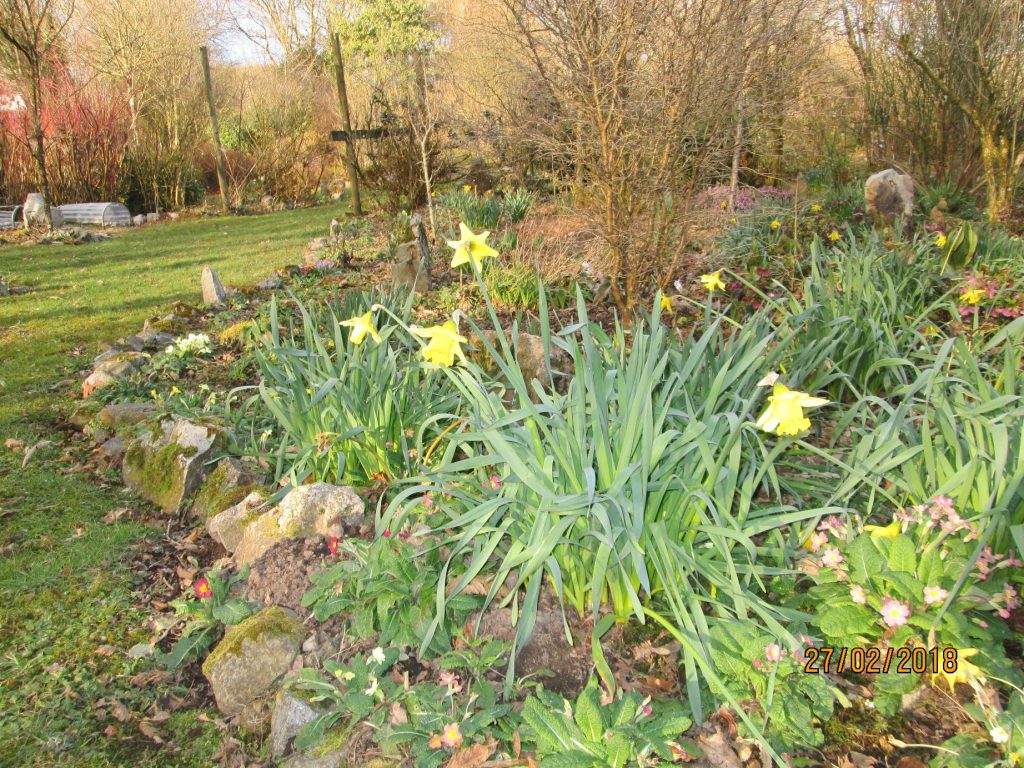
We fly our flag too of course, the flag we call Y Ddraig (The Dragon) after what it depicts. It’s one of the few in the world that shows a Pagan spiritual symbol. Which is perhaps why it isn’t included in the composite ‘Union flag’ of the UK, comprised of the symbols of three other purported saints. . There is a recently-invented cross-style flag for ‘Saint David’, but I suspect the UK government is still ignorant of it. Y Ddraig for me anyway.
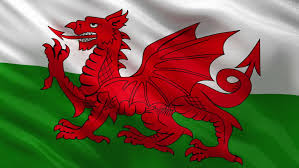
I doubt that many people really believe a word of the ‘Saint David’ hagiography, but it isn’t generally acknowledged that the whole thing was invented in the 11th century, basically as propaganda in a dispute as to which Welsh bishopric would have precedence. As usual with these fables, the scribe just nicked a few cherries from Pagan tradition, recombining the places and the images into their own fantasy. One of the more amusing ‘borrowings’ from the real Dewi is the ancient title ‘Dewi Dyfyrwr’ – Waterman. The hagiography pretends that this is because their saint didn’t drink beer!
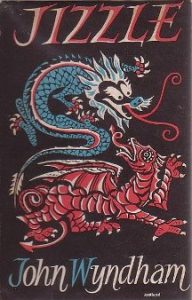
Mostly, we simply speak of Y Ddraig, but actually, His name is Dewi. This isn’t just a fancy – though it’s pleasant enough, as in the imitation dragons (Dewi and Dwynwen, complete with babies Cariad and Dylan) that have been constructed at Ccaerffili Castle. Dewi is the male, the red chunky one. There is a tradition, not necessarily invented by the author John Wyndham, that female dragons are blue and slinkier.
In the case of Dewi, we can see that knowledge is liberation. If one has only ever heard of ‘Saint David’ then all historical mention of ‘Dewi’ would have to be of the ‘saint’, but once one knows of the real Dewi, we realise that when people write of “Dewi”, it’s really Him! For example, the earliest known reference to Dewi is in the very anti-English 10th ce poem ‘Armes Prydain Fawr’ (‘Prophecy’ or ‘Calamity’ of Great Britain). The quote is “A Lluman glân Dewi – a ddyrchafant”; that is: “And they will raise the pure banner of Dewi”. Medieval Welsh poets often compared their leaders to dragons in poems praising their bravery, for example, Gruffydd ab yr Ynad Coch said of Llewelyn ap Gruffudd Pen dragon, pen draig oedd arnaw (‘A dragon’s head he had’).
By now, Dewi has become the best known Spirit of our Land. More properly, he is a God of the Rivers. Many of the rivers of our land bear his name in some form or other: these include the Taf, Taff, Teifi, Towy, Tawe, Tywi and Dyfi. It does rain a lot here, so the rivers flow strongly! It would be nice to think that the Daffodil, the national symbol of modern times, derived its name from him also, but sadly not it seems – apparently it’s a medieval mixup from the quite different flower named asphodel, which in ancient Greece was said to grow in the meadows of the otherworld. In Welsh, the names of the leek (the original national emblem) and daffodil are close – leek is Cenhinen, daffodil is Cenhinen Pedr.
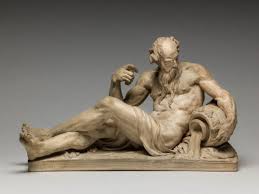
Dewi’s banner definitely has a history. Apparently, it has been traced back to various auxiliary cavalry units in the second century ce Roman army. Some of these came from Sarmatia – an area at the edge of the Empire broadly corresponding to modern Ukraine. After defeating a people, the Roman army typically took in new soldiers from its former opposition, in effect as hostages against genocide. These were then sent as far as possible from home to subdue yet more barbarians. Divide and conquer. The Sarmatians flew their banners in the manner of a wind sock. The Greek military writer Arrian describes the draco – “during a cavalry charge they are inflated by the wind and even make a sort of hissing sound as the air is forced through them”. The Sarmatians brought their dragon banners to Britain, where they seem to have found near relationship with the tribes they met, including, we may guess, a close language similarity within the Celtic diaspora. (We tend to forget that Celtic culture actually began in central Europe, after a rather earlier Indo-European movement from the Ukraine area, then spreading in all directions, in our case until the Atlantic Ocean.) The Sarmatians were indeed Cymry – fellow countrymen, and their descendants apparently fought with Arthur against the Saxons.
It is claimed that the mother of ‘Saint David’ was another saint, “Non”, raped by a local prince. This silliness cunningly hides a further thread of the real story. Non is really the local Spirit of the sacred wells and springs, which surely are the Mothers of the Rivers. The purported birthplace of David is Non’s Well near the city of Tyddewi (again, no ‘saint’ in the Welsh name) and there are at least three other places in Wales named after Her – Llan-Non = ‘sacred enclosure of Non’s spring’, one is on the next hill east from here. She is honoured in Cornwall too, with a church of ‘St Nonna’ nearby a sacred well in the modern village of Altarnun. There isn’t much in the way of traceability for Non. We may guess that Her name, rather than being derived from the English word ‘nun’ (in Welsh, ‘lleian’) is actually related to that of the Well Goddess of England, herself remembered in the many sacred wells dedicated to ‘Saint’ Anne (or sometimes Antony, as at Llansteffan). Christian fables tell of Anne as being ‘of the house of David’ and as the mother of Mary (who is also the sea…) so all that would make sense of a sort.
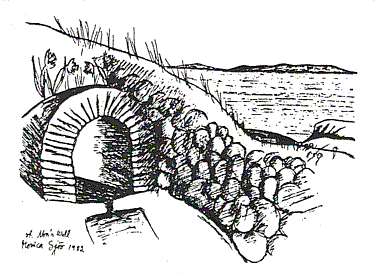 Monica Sjoo, author of ‘The Great Cosmic Mother’, who lived in Sir Penfro for a number of years, wrote that “St. Non’s Well has trance-inducing powers, and its still waters can act as a scrying mirror. Many a time I have sat there by the well dreaming and meditating”. Monica further linked the Well to a physical power that would be helpful in childbirth. Her s account is at http://people.bath.ac.uk/liskmj/living-spring/sourcearchive/fs1/fs1ms1.htm
Monica Sjoo, author of ‘The Great Cosmic Mother’, who lived in Sir Penfro for a number of years, wrote that “St. Non’s Well has trance-inducing powers, and its still waters can act as a scrying mirror. Many a time I have sat there by the well dreaming and meditating”. Monica further linked the Well to a physical power that would be helpful in childbirth. Her s account is at http://people.bath.ac.uk/liskmj/living-spring/sourcearchive/fs1/fs1ms1.htm
So how can we celebrate Dewi, Y Ddraig, in our modern Paganism (other than cheering the Wales Rugby team in the Six Nations tournament that’s underway each year at this time )?
Two thoughts: firstly, something practical and political – visit your local well or spring, or if you can locate it, the source for your domestic own water supply. Say your prayers and sing your songs, but make sure you take a carrier bag or two and first clean up any litter. Whether individually or in a group, you could well link this to an action against fracking, since that madness is likely to cause irremediable poisoning of the Waters in the Earth. (Join Druids Against Fracking: https://www.facebook.com/groups/Druidsagainstfracking/)
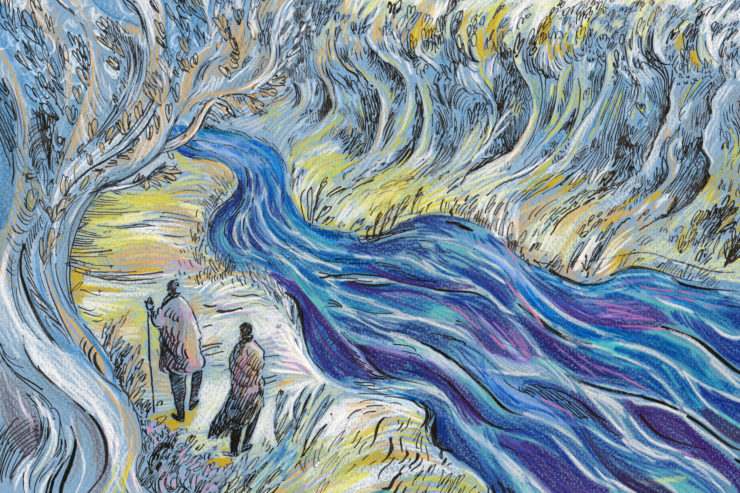
Secondly, something more ritual / personal / family-related: when my children were young, I was first introduced to the idea of the Earth Dragon by poet Hilary Llewelyn Williams, who celebrated likewise with her young children. We made a stuffed cloth ‘dragon’ who, with a mortal accomplice, had to ‘hide’ out in the garden. She is Asleep, and has to be woken. Finding Her takes some time, but whilst searching one can find lots of small chocolate spheroids as evidence of where She’s been (children enjoy this bit of course). When She is eventually found, She takes a lot of waking (getting on a bit after all) so this takes a lot of noise. She often complains that it’s can’t quite be time to wake as people aren’t singing loudly enough. (Bang the drums some more!)
Or perhaps, combine these! Wake up the Dragon at your local watersource with drums, song, bagpipes and laughter! (You’re welcome to use my song below)
A couple of years back I was inspired to create a song to the Earth Dragon, awakening at this time. I set it to the tune of the Serbian dance Setnja, so that dance for me is now firmly associated with both Dydd Dewi and Spring Equinox. My words bear no relation to the Serbian song lyric that is sometimes used. It’s a pretty easy dance, basically a fancy walk, that any group could do if they liked the idea.
It’s danced in an ‘open circle’ (curving line) anticlockwise – left hand rests on hip, right arm through left of person in front (like teapots!)
- Step R first, around notional circle – slow, slow, quick quick slow (R L RLR)
- Then swivel slightly on the spot to face more centrally: take two slow steps L R back (so outwards) then three ‘change your mind’ steps – back, close, forward (LRL)
- And repeat – traditional music tends to start slowly and speed up. You can see a small group dancing it here: https://www.youtube.com/watch?v=ATDFVhMWPiU
Two great versions of the music, instrumental only, can be found and purchased at minimal cost from ‘Freedonia State Orchestra’ https://nicholasbreezewood.bandcamp.com/album/freedonia-state-orchestra.
Here’s my song and the basic melody line.:
Dragon Wake, Rouse Your Powers,
All Earth Greets You with Brightest Flowers
Dragon Rise, Dance and Sing
All Earth Calls You Spring-time Bring.
Dragon Wise, Oldest One,
All Earth Welcomes the Spring-time Sun
Dragon Fire, Lift in Flight
All Earth Leaps in Springs Delight
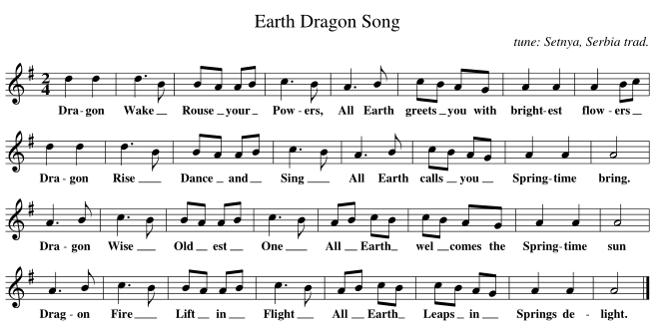
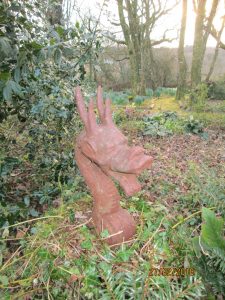
Dydd Gwyl Dewi Hapus!